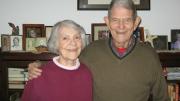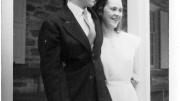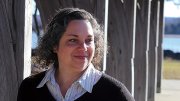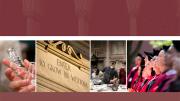Staughton Lynd ’50, Ds ’52, jokes that he won over his wife, Alice (Niles) ’52, with a dinner of hamburgers and green peas at his Story Street apartment. She piqued his interest when she asked if he or his roommates had read Keith Hutchison’s The Decline and Fall of British Capitalism. “As a young radical, I was very impressed,” he says.
Fifty-eight years later, these two radicals are still going strong, documenting their partnership in Stepping Stones: Memoir of a Life Together (2009), a chronicle of their shared involvement in some of the era’s most notable social movements, from the civil-rights struggle and antiwar protests to justice for workers and prison reform.
“I think that part of what was so extraordinary about Staughton was that he cared about things that mattered,” Alice says. Raised by activist parents, each partner describes a lifelong drive to work for social change. “I think it came from our mothers’ milk,” says Alice.
Staughton’s parents had partnered professionally as coauthors of the “Middletown” studies of Muncie, Indiana, now classics in American sociology. The younger Lynds have followed suit, co-writing a number of books, including their 1973 oral history, Rank and File: Personal Histories of Working Class Organizers, to set beside Staughton’s prolific solo writings, such as his 1968 Intellectual History of American Radicalism.
Their newest book, however, is the first time they have focused on their own marriage, and Alice initially resisted the undertaking. “I felt that it was much more important to be doing something now than writing about the past,” she explains, but she no longer has any regrets about the project.
As the book recounts, these self-described “Quaker-Marxists” spent part of their early marriage in the South, first on a Georgia commune, and later at Atlanta’s historically black Spelman College, where Staughton, fresh from earning a doctorate in history at Columbia, took a teaching job. He worked there for two years, one summer coordinating the Mississippi Freedom Schools, before moving to Yale’s history department.
He became famous and rather infamous at Yale, when, as a pacifist and conscientious objector, he used his winter break to visit Hanoi during the Vietnam War. Denied tenure and unable to get a teaching position elsewhere, he eventually earned a law degree from the University of Chicago and began to practice. Alice switched from early childhood education to work as a draft counselor and paralegal.
Even as they found a greater partnership in their legal work, the parents of three came to realize that their staunch commitment to causes could cost more than jobs; it could strain the family, too. Alice says, “We had to decide that our relationship and our family were going to be primary, and it didn’t make any sense to run around trying to create a better world and leaving chaos at home.”
In 1976, after years of relocating, the family left Chicago for Youngstown, Ohio, the place they have called home longer than any other. It was the kind of unexpected option Staughton wishes others would take. “I think if more bright, young people would move out of Cambridge, New York, and Berkeley to Youngstown, Topeka, Mobile, you name it, it would be good for the United States,” he says. “We would be much less isolated as a community of questionable eggheads.”
Initially the couple moved to Youngstown to take legal action against steel-mill closings; though that effort ultimately failed, they have since forged a new path in the Rust Belt city. At 52, Alice enrolled at the University of Pittsburgh to get her own law degree, and then joined her husband as a full partner in the courtroom. Both retired in 1996, but continue legal work to end the death penalty. In that respect, Staughton says, not much has changed from his days at Harvard: “At age 16 and 17, I wanted to find a way to change the world, just as I do at age 79.”
Still, in the lives of these radicals, perhaps no group or cause has meant more than their own “two-person community,” a partnership that is still standing in solidarity nearly six decades later. As Alice says, “We really do believe that anything that we can do together, we do better than either one of us alone.”










